How Snakes & Charlatans Corrupted Christianity Back To The Neopagan Self-Help Section
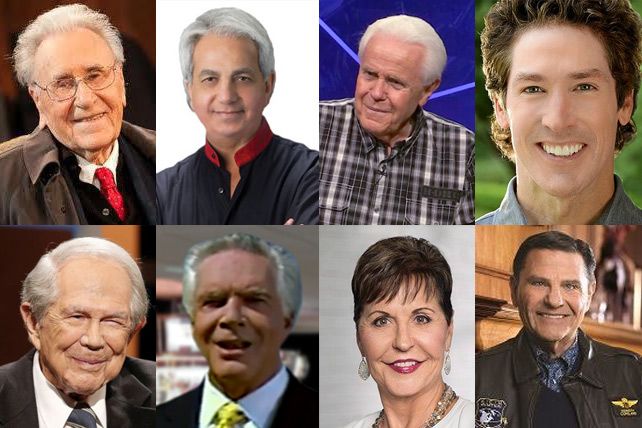

Paganism and Christianity have a long, fractious history. Broadly-speaking, Christians regard Pagans with a spiritual distrust; in return, Pagans tend to regard the Church as an oppressive structure to be liberated from back to their ancient ways. Those in the middle see a blurred melting pot of borrowed concepts and overwritten calendar holidays. Both are also collective terms for families of beliefs and practices.
According to Pagan International (paraphrased), there are six-ish traditions which define the family of practices (“paths”):
- “Pagans pursue their own vision of the Divine as a direct and personal experience.”
- “The Pagan outlook can be seen as threefold. Its adherents venerate Nature and worship many deities, both goddesses and gods.”
- “The spirit of place is recognised in Pagan religion, whether as a personified natural feature such as a mountain, lake or spring.”
- “The many deities of Paganism are a recognition of the diversity of Nature. Some Pagans see the goddesses and gods as a community of individuals much like the diverse human community in this world.”
- “Pagan religions all recognise the feminine face of divinity. A religion without goddesses can hardly be classified as Pagan.”
In a nutshell, obsession with Earth, “sacred spaces”, femininity as god, equality of all things, and diversity. Sound familiar? These are not new ideas.
There is one enormous dividing line between the two which entirely distinguishes them from each other, however (aside from mono vs poly-theism): for lack of a better term, where divinity can be found.Those under the pagan (or neo-pagan) umbrella — along with their Eastern cousins — believe it can be found within the manifold of the universe, space, and time as an impersonal force. Christianity, inversely, firmly places God as a person who outside those, as its Author.
Most people who thoughtlessly utter empty platitudes about the “universe” having a “plan”, or their awareness of energy “vibes”, aren’t aware they are espousing what are, for better or worse, essentially pagan beliefs.
In turn, those who have grown up in cultures where Christianity is the predominant religious force are equally unaware their understanding and values — such as creation, tolerance, forgiveness, plurality, etc — find their source in the Bible. Of course, that is disputed by those who aren’t fans of Christianity.
Christianity itself has taken many turns: from England’s divorce from Rome to create Protestantism; to Luther’s English Bible translation initiating the Reformation; to the friction with Darwin and the Enlightenment; to the doctrinal fracturing of the Jehovah’s Witnesses and Mormonism; all the way through to postmodern secularism, gay marriage, New Atheism, and clerical sexual abuse.

Both sets of beliefs are vulnerable to the concept of Magical Thinking(attributing chance, recognising patterns etc), albeit one far more than the other. Whereas Christianity claims the person of a Creator has revealed Himself and intervened in Being as an act of super-nature, Paganism and its collective categories virtually embrace ephemera and Magical phenomena as the core of their worldview.
“Magical thinking: the belief that one’s ideas, thoughts, actions, words, or use of symbols can influence the course of events in the material world. It is common in very young children.”
Creeping Syncretism Is Back in Vogue
There is, however, a modern corruption of biblical doctrine which has been plaguing churches of all denominations and been growing for decades, like a cancerous mould under the carpet. The denunciations are, in turn, growing in volume, as dissent mounts. Few, if any, Christians are aware of its root, and even fewer are aware of how deeply it has seeped into every capillary of the Christian life as populist orthodoxy.
It’s a disease few recognise, or are able to iterate. They are able to point to its symptoms on occasion, but rarely to its source, or its spread and influence.
Its manifestations include the “Prosperity Gospel”, the manifestation of real-world results due to “positive thinking”, and in some places, magical thinking and spiritual “healing”. Mega and micro churches on the ends of the spectrum tend to suffer it most acutely.
The Mind-Cure Movement: A Step Up From Leeches
Seeking “hidden” or alternative knowledge isn’t exactly a new idea (the Garden of Eden springs to mind). From the Gnostic sects of the first centuries AD; to the delightful Aleister Crowley, to the meta-nuts and their Sumerian reptilians.

The Age of Enlightenment didn’t reach everyone. At the turn of the 19th Century, one of the most widespread beliefs developing in Europe derived from German physician Franz Mesmer’s scientific tinkering — “Mesmerism”, “animal magnetism”, or what we now know as hypnotism. Mesmer was curious about how blockages of a theorised magnetic fluid in the body caused disease.
His theory proposed there was an invisible natural force (Lebensmagnetismus, or “animal magnetism”) possessed by all living things, — including humans, animals, and vegetables — which could have physical effects, including healing. He also believed his will could affect it in his patients.
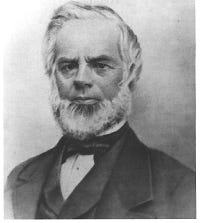
Around 1840, a young American clockmaker who had suffered tuberculosis all his life in New England, Phileas Quimby, gave up everything to follow a French mesmerist named Charles Poyen, who was on tour amongst cultural chatter of “energy medicine”. Fast-forward a few decades, and Quimby had developed an entire belief system on the basis of a simplistic hypothesis: that all illness originated in the mind due to negative beliefs, i.e. disease is rooted in some kind of mental cause.
Ergo, if the mind were to be “corrected” of the wrong thinking, a person’s life, and/or their body, would be healed of what ailed them. A person could create or alter their reality through their thinking.
In Quimby’s own words:
“The trouble is in the mind, for the body is only the house for the mind to dwell in . . . If your mind has been deceived by some invisible enemy into a belief, you have put it into the form of a disease, with or without your knowledge. By my theory or truth, I come in contact with your enemy and restore you to health and happiness.”
We obviously know this to be objectively untrue now in the physical realm, having a much deeper understanding of pathogens, transmission, and the role of random chance (accidents, for example). Science inevitably gave birth to the science of psychology, and techniques such as cognitive behavioural therapy. We also recognise mental state can affect susceptibility to disease.
Horatio W. Dresser explained Quimby’s ideas in a seven element list.
1. The omnipresent Wisdom, the warm, loving Father of us all, Creator of all the universe, whose works are good, whose substance is an invisible reality.
2. The real man, whose life is eternal in the invisible kingdom of God, whose senses are spiritual and function independently of matter.
3. The visible world, which Dr. Quimby once characterized as “the shadow of Wisdom’s amusements”; that is, nature is only the outward projection or manifestation of an inward activity far more real and enduring.
4. Spiritual matter, or fine interpenetrating substance, directly responsive to thought and subconsciously embodying in the flesh the fears, beliefs, hopes, errors, and joys of the mind.
5. Disease is due to false reasoning in regard to sensations, which man unwittingly develops by impressing wrong thoughts and mental pictures upon the subconscious spiritual matter.
6. As disease is due to false reasoning, so health is due to knowledge of the truth. To remove disease permanently, it is necessary to know the cause, the error which led to it. “The explanation is the cure.”
7. To know the truth about life is therefore the sovereign remedy for all ills. This truth Jesus came to declare. Jesus knew how he cured and Dr. Quimby, without taking any credit to himself as a discoverer, believed that he understood and practiced the same great truth or science.
Quimby recognised the Placebo effect, and how excitement and/or hypnosis could affect the sensation of physical pain. Mesmer’s ideas carried on with Sigmund Freud.
New Thought: Old Magical Rope
But the “mind-Cure” was a highly infectious idea in Western Esotericism; one which aroused the curiosity of a lot of people.
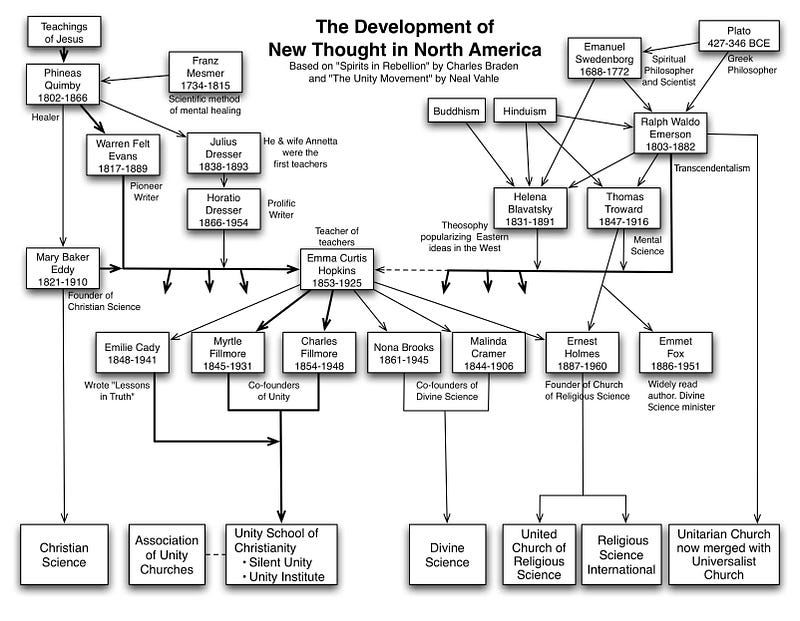
In 1869, Warren Felt Evans published his first works on “mental science”. In 1886 Prentice Melford published essays on “Forces”, slightly before William Walker Atkinson built on them with his idea of “thought vibration” and role of creative visualisation in the so-called “Law of Attraction” in 1906 just after Ralph Waldo Trine’s “In Tune with the Infinite”. In 1888 the Church of Divine Science arrived, one year before the Unity Church in 1889.

One of Quimby’s students (“patients”) during the 1860s — just before she danced with spiritualism in the years that came afterwards — was Mary Baker Eddy, who went on to found the wacky Church of Christ, Scientist (Christian Science). It was later followed in 1927 by Religious Science. Eddy, amongst others, taught Emma Curtis Hopkins.
Striking in Eddy’s pot of nutty ideas was “malicious animal magnetism”:
“The converse of mental healing was the use of mental powers to destroy people’s health — what Eddy termed “malicious animal magnetism.” She was concerned that a new practitioner could inadvertently harm a patient through unenlightened use of their mental powers, and that less scrupulous individuals could use such powers as a weapon.”
Which, naturally, bears striking similarities to the nutty ideas of pagans and their good vs. bad “magick”, Scientology’s “OT” levels, and of course, Spiderman.
The Christian Gospels became a syncretic shit pie of Transcendentalism, Berkeleyan Idealism, Spiritism, and Hinduism.

It collectively became known as the “New Thought” Movement.
In 1916, they codified a Declaration of Principles (later modified in 1957 to remove the Christian-y bits), which included the greatest hits, such as:
4. WE AFFIRM THE POWER OF PRAYER AND THE CAPACITY OF EACH PERSON TO HAVE MYSTICAL EXPERIENCE WITH GOD, AND TO ENJOY THE GRACE OF GOD.
[snip]
7. WE AFFIRM THAT OUR MENTAL STATES ARE CARRIED FORWARD INTO MANIFESTATION AND BECOME OUR EXPERIENCE IN DAILY LIVING.
8. WE AFFIRM THE MANIFESTATION OF THE KINGDOM OF HEAVEN HERE AND NOW.
The founding tenets of New Thought beliefs, according to Wikipedia, can roughly be expressed as:
Infinite Intelligence or God is omnipotent and omnipresent.
Spirit is the ultimate reality.
True human self-hood is divine.
Divinely attuned thought is a positive force for good.
All disease is mental in origin.
Right thinking has a healing effect.
Pax Britannica was in full swing with Darwin, but over the puritanical Pond, Joseph Smith’s conmanship (1820) and Spiritualism (1840) had taken root in New York.
But by far the most important disciple in the 1890s — as far as modern-day Christianity is concerned, was a young Methodist deacon named Essek William Kenyon. Along with his own student Kenneth Hagin, they gave birth to a rather nefarious brainchild.
Positive Confession: Metaphysics gone Jesus-ish
E.W Kenyon liked Quimby a lot in his days at Emerson College of Oratory (Emerson himself was a Christian Scientist), and thoroughly prided himself on the biblical strength of his ideas. He also liked the Methodist Holiness Movement, and the Higher Life Movement.

A summary of his history is eerily similar to a certain Texan preacher’s family:
“ The Kenyons opened a bible school and began to train the young people. They purchased a farm and called it Bethel Bible School. They lived on faith every step of the way, struggling with financial need, but depending on God. Kenyon moved west in 1923, and settled in California where healings were a regular part of his ministry. He started a church which grew to about a thousand members. Then he moved to Seattle where he established New Covenant Baptist Church. He began a radio ministry, a Bible Institute, and the Herald of Life publication.”
After switching to being a Pentecostal Baptist, he began to merge the mystical “teachings” of “mind science” with Christianity, eventually becoming widely known as the most prominent director of a “Bible Institute” in 1898, emphasising the benefits of “Positive Confession”:
“Positive confession is the practice of saying aloud what you want to happen with the expectation that God will make it a reality. To confess positively is to speak words that we believe or want to believe, thus making them reality. This is opposed to negative confession, which is to acknowledge hardships, poverty, and illness and thus (supposedly) accept them and refuse the ease, wealth, and health God has planned for us.”
Inversely, “Negative Confession” is when you “speak negative things over yourself”.
If you’re a Christian reading any of that, the horrid knot in your stomach isn’t dinner. You recognise it but probably didn’t know it had a name. Don’t worry. It gets worse.
Kenyon went further, as they always do. He was smart enough to subtly divide “revelation through the senses” and “revelation through the spirit”.
Word of Faith: Use the Force, Oh Disciple
During the eras of the two world wars, New Thought generally tinkered along in the background as greater events took precedence.
In 1937, Oliver Napoleon Hill repackaged Prentice Mulford’s “Law of Attraction” concept, and published “Think and Grow Rich”. His formulation of 16 “laws” compressed into 13 principles has sold over 100M copies. He got very rich.
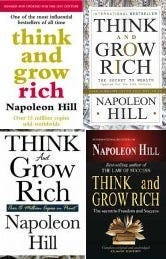
Hill’s book, however, isn’t in the business section. He was a spiritualist. A note on Chapter 26 of its 1967 successor has a rather curious diversion from getting the cashola:
“Hill states that the “Master” spoke to him audibly, revealing secret knowledge. Hill further insists that the Masters “can disembody themselves and travel instantly to any place they choose in order to acquire essential knowledge, or to give knowledge directly, by voice, to anyone else.” Grow Rich! With Peace of Mind was heavily influenced by Hill’s spirit voices; Hill cites the “Master”, saying, “Much of what he said already has been presented to you in the chapters of this book or will follow in other chapters.”
That sounds a bit like Crowley’s “revelation” from “Aiwass” circa 1904, and/or Theosophy’s Helena Blavatsky’s sci-fi idea of Tibetan Mahatmas.
Around the same time, a Texan preacher named Kenneth E. Haginfounded a Non-Denominational (Assemblies of God) Baptist church in Roland, TX — after a round of dramatic “miracles” he claimed to experience.

Hagin had lots of miracles. Jesus visited him a few times; he went to hell, apparently, and naturally, there were “Laws of Faith”:
Hagin claims Jesus told him, “If anybody, anywhere, will … put these [positive confession] principles into operation, he will always have whatever he wants from Me or God the Father” (Charismatic Chaos, p. 281).
Despite being relentlessly accused of plagiarising Kenyon, he became known as the father of what we now call the “Word [of] Faith Movement”.
Word of Faith (also known as Word-Faith or simply Faith) is a worldwide Protestant Christian movement which teaches that Christians can access the power of faith or fear through speech. Its teachings are found on radio, the internet, television, and in many Charismatic denominations and communities. The doctrine renounces poverty, suffering, and defeat as necessary to a godly life and glorifying Jesus Christ. It teaches that the salvation won by Jesus on the cross included health and prosperity for believers.
Dear oh dear. A lot of Christians will recognise this doctrine instantly.
Word-Faith, or WOF, is some Jedi-like speech magic. You can “declare things over your life”, we can “speak things into existence”, and you shouldn’t “speak bad things over your life”.
“At the heart of the Word of Faith movement is the belief in the “force of faith.” It is believed words can be used to manipulate the faith-force, and thus actually create what they believe Scripture promises (health and wealth). Laws supposedly governing the faith-force are said to operate independently of God’s sovereign will and that God Himself is subject to these laws.”
The “Word of Faith” Movement has a lot you can say about it, but digging into the belief canon leads from completely batshit ideas (Adam could fly, humans are little gods) to an assortment of outright cult theology.
- “Satan had gained ascendancy in the earth by gaining Adam’s authority, and God was left on the outside. God couldn’t come here in His divine power and wipe them out. He had to move in an area where it would be ruled legal by the Supreme Court of the Universe”
- “You create the presence of Jesus with your mouth….He is bound by your lips and by your words … Remember that Christ is depending upon you and your spoken word to release His presence”
- When Jesus was in the pit of hell, in that terrible torment, no doubt the Devil and his emissaries gathered around to see the annihilation of God’s Son. But in the corridors of hell, there came a great voice from heaven: “Turn Him loose! He’s there illegally!” And all of hell became paralyzed.
- “Adam was an exact duplication of God’s kind!….Adam was subordinate to God. God created him, gave him all this authority and power, and said to him, ‘Be god over the earth as I am God over the heavens’”
- Faith is a force. “Faith is a power force. It is a tangible force. It is a conductive force”
- “The force of faith is released by words. Faith-filled words put the law of the Spirit of life into operation”
Needless to say, it would be generous to say any of it is remotely biblical. Hagin passed the baton to Kenneth Copeland, the hilariously-named Oral Roberts (“godfather of the charismatic movement”), Benny Hinn, and the Trinity Broadcasting Network (TBN).
“Word of Faith” ideas came to be concisely summed up as a set of aberrant affirmations with no basis whatsoever in traditional Christianity:
- Spoken Words Change Reality
- God Himself Uses Faith
- Humans Are Little Gods
- Jesus Was Born Again In Hell
- Physical Healing Is Guaranteed
- Financial Wealth Is Guaranteed
Meanwhile, as Hagin was getting into his flow, and Gerald Gardner was bringing back legit witchcraft, another young pastor was raking in the cash in the early fifties.
Positive Thinking: It Solves Everything, and Stuff
In 1952, former Methodist Norman Vincent Peale, aka “God’s Salesman”, published the most famous of his 46 books — some of the most popular of the last 100 years — : “The Power of Positive Thinking”.
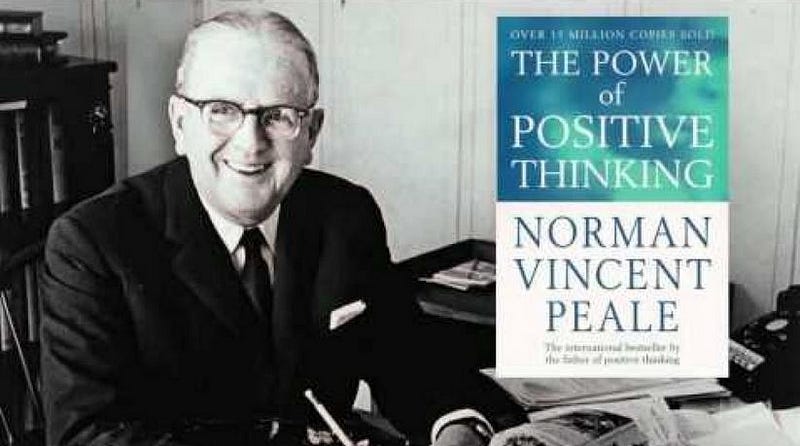
Lo and Behold, 10 rules. Faith. Your thoughts can cure you, and affect material reality. Your thoughts can cure physical illness. Thoughts attract the same kind of thoughts. Reach out to a Higher Divine Power.
“It’s almost as if there were an invisible reservoir of abundance in the universe that can be tapped if you will just obey certain spiritual laws.” (POPT, quote)
And curiously, accusations the book itself bore a worrying similarity to Mesmerism.
Peale himself, it appears, took a much wider diversion from his plagiarism of Christian Science, right over to the pagan “many paths” approach:
“It’s not necessary to be born again. You have your way to God, I have mine. I found eternal peace in a Shinto shrine … I’ve been to Shinto shrines and God is everywhere. … Christ is one of the ways! God is everywhere.”
“Positive Thinking” and its supposedly mystical effects are so widespread from 90s Yuppie culture they are axiomatically embedded in our thought processes. After all, who is going to argue with being optimistic if it also means your thoughts can do magic?
Boomer Hippies: Record-Breaking, Next-Level Bullshit
The 60s gave rise to some truly batshit crazy ideas, such as Hubbard’s sci-fi religious Ponzi scheme (Scientology), Michael Murphy’s Esalen Institute (the “Human Potential Movement”, we only use 10% of our brains etc), French postmodernism (Derrida et al, the objective is just subjective etc), and the incumbent orthodoxy that everything is language and all reality is “socially constructed” (Social Constructionism, 1966).
100 years after hypnotism had gripped Quimby, we were at it again.

By the early 1970s, the batshit was nearing its zenith — not just with cults — but in the “New Age [of Aquarius]”, i.e. the New Age Movement. Few people are now unfamiliar with this nonsense, which featured yet more “hidden” knowledge from Eastern religion: from crystals, to astrology, to Mayan philosophy, to energy healing, to communes, to batshit UFO teleportation.
A few of the best-known yet stupidest pieces of literature — essential for any true idiot’s bookshelf collection — from this period included:
- Louise Hay’s “You Can Heal Your Life” (1984)
- Paulo Coelho’s “The Alchemist” (1988)
- James Redfield’s “The Celestine Prophecy” (1993)
- Don Miguel Ruiz’s “The Four Agreements” (1997)
- Eckhart Tolle’s “The Power of Now” (1997)
And of course, the king of utter horseshit, that mystical Snake OilSalesman, Deepak Chopra. with his quantum depth of dumb, “The Seven Spiritual Laws of Success”.
Chopra achieved such impressive levels of contempt by scientists, he has to be commended. Indeed, on his “quantum” mysticism alone:
“Reviewing Susan Jacoby’s book, The Age of American Unreason, Wendy Kaminer sees Chopra’s popular reception in the USA as being symptomatic of many Americans’ historical inability (as Jacoby puts it) “to distinguish between real scientists and those who peddled theories in the guise of science”. Chopra’s “nonsensical references to quantum physics” are placed in a lineage of American religious pseudoscience, extending back through Scientology to Christian Science. Physics professor Chad Orzel has written that “to a physicist, Chopra’s babble about ‘energy fields’ and ‘congealing quantum soup’ presents as utter gibberish”, but that Chopra makes enough references to technical terminology to convince non-scientists that he understands physics. English professor George O’Har writes that Chopra is as an exemplification of the fact that human beings need “magic” in their lives, and places “the sophistries of Chopra” alongside the emotivism of Oprah Winfrey, the special effects and logic of Star Trek, and the magic of Harry Potter.”
Michael Crichton, author of “Jurassic Park” noted the emergence of environmentalism as a neo-pagan religion, as J.K Rowling was inspired by Victorian times and writers to pen the “Ministry of Magic” in “Harry Potter”.
Then, of course, there was Dr Oz. And he made some great cash bringing back the absurdity of home witchcraft (homeopathy) and lending it real legitimacy on TV. Not to mention his interests in communication with spirits, energy healing, and Reiki.
Oprah & The Prosperity Preachers
As the post-War Counter-Culture took hold with its vain intentions to Save the World and change everyone’s “consciousness”, American evangelicals weren’t going to be outdone in the great contest for spiritual meaninglessness.

After miraculous revelation in 1947, a travelling faith preacher in Oklahoma, Granville Oral Roberts, was claiming he could “raise the dead” and preaching a new, religiously-flavoured version of the American Dream: prosperity, the blessing pact, and “seed faith”. The so-called Abundant Life.
According to Oral Roberts, the way to take advantage of the law of sowing and reaping is three-fold: 1) look to God as your source, 2) give first so that it may be given to you, and 3) expect a miracle.
Roberts was almost imperialistic in his ambition. In 1963, he even founded Oral Roberts University and the first weekly evangelical television program. The era of highly-profitable televangelism had begun: preachers announcing they would die if they didn’t raise enough money, as they had visions of Jesus telling them to build large things.
It worked well. The New York Times’ obituary of Roberts stated that at its peak, Roberts’ $120M employed 2300 people on a $500M estate. He became known as the “Godfather of the Charismatic Movement”.
Right there in the mix were Asa Alonso Allen, Tommy Lee Osbourne, Benny Hinn, as well as Kenneth Copeland (Roberts’ chauffeur) and Kenneth Hagin, both from “Word-Faith” fame. A whole ass-tonne of scandals followed.

All supposedly had rather dramatic “miracle” experiences in their youth as insignificant church workers, which led to mass media teaching, and eventually, private jets. And they had seen Jesus in-person.
Inspired by Carnegie’s “Gospel of Wealth”, Kenyon/Hagin’s “Word-Faith” movement from New Thought, American pragmatism, and whole world of Baptist zealotry, they formed the Neo-Pentecostal Movementand taught the all-new, all-sparkling, deeply-unholy and unbiblical Prosperity Gospel. Also known as the “health and wealth” doctrine, or “name it and claim it”. Poverty was just a case of “mindset” and is derived from a lack of faith.
At the heart of the new “gospel” were some surprising theological leaps:
1. The Abrahamic covenant is a means to material entitlement.
2. Jesus’s atonement extends to the “sin” of material poverty.
3. Christians give in order to gain material compensation from God.
4. Faith is a self-generated spiritual force that leads to prosperity.
5. Prayer is a tool to force God to grant prosperity.
In more modern times, pastors have given more specific standards to detect such chicanery. For example, John Piper suggests a few key things to look for:
1. The absence of a serious doctrine of the biblical necessity and normalcy of suffering, the absence of a doctrine of suffering.
2. The absence of a clear and prominent doctrine of self-denial is a tip off that something is amiss.
3. The absence of serious exposition of Scripture.
4. The absence of dealing with tensions in Scripture.
5. Church leaders who have exorbitant lifestyles.
6. A prominence of self and a marginalization of the greatness of God.
Inadvertently or not, these same group of people — knowingly or unknowingly — pioneered a form of behavioural science, which John Antonakis named Charismatic Leadership Tactics (CLTs).
- Metaphors (showing how smart you are)
- Stories & anecdotes (most remembered parts of a speech)
- Moral conviction (showing honesty and integrity)
- Collective sentiments (more concern for followers than yourself)
- High expectations for yourself and followers (crises need special talent)
- Confidence (follow me over anyone else)
- Rhetorical questions (your vision is mine)
- Body gestures (appear big and important)
- Facial expressions (audiences unconsciously mimic them)
- Animated voice tone (preserving interest)
Televangelism was mass-market international sales gold for churches. Business was booming.
So was Oprah.
Her “miraculous” story — objectively an extraordinary feat by any contemporary standard — of rising from poverty to the most influential person in media had captured the public’s imagination. She had transformed the plain talk show format into a form of public confession and featured gay people on mainstream television for the first time.

After her legendary interview with Michael Jackson, everything seemed to change. Christianity Today observed:
“Since 1994, when she abandoned traditional talk-show fare for more edifying content, and 1998, when she began ‘Change Your Life TV’, Oprah’s most significant role has become that of a spiritual leader. To her audience of more than 22 million mostly female viewers, she has become a postmodern priestess — an icon of church-free spirituality.”
So began the channel for a river of worse and worse ideas. A constant, unrelenting flood of superstition, worn Eastern philosophy, New Thought, pseudoscience, and feelgood fluff. All mixed in with a lot of confession and highly-emotional therapeutic talk. It made her a billionaire, as if by… magic.
One story had remarkable consequences, an eventually gave birth to the largest church in America. Right there in Texas, where Hagin had worked to put the horse before the cart all those years ago.
The Meyer/Osteen Oprah Dynasties
The 50s were a rough decade for a young Texan Baptist preacher named John Hillery Osteen. He had divorced his first wife, resigned his pastorate, and his first child from wife #2 had been born with serious health issues (“a condition similar to cerebral palsy”). John changed course when the “miracles” started. In 1959, in true Kenyon spirit, he disavowed any denomination, wherein he and wife 2 spotted an old dusty storefront and founded Lakewood Baptist Church.
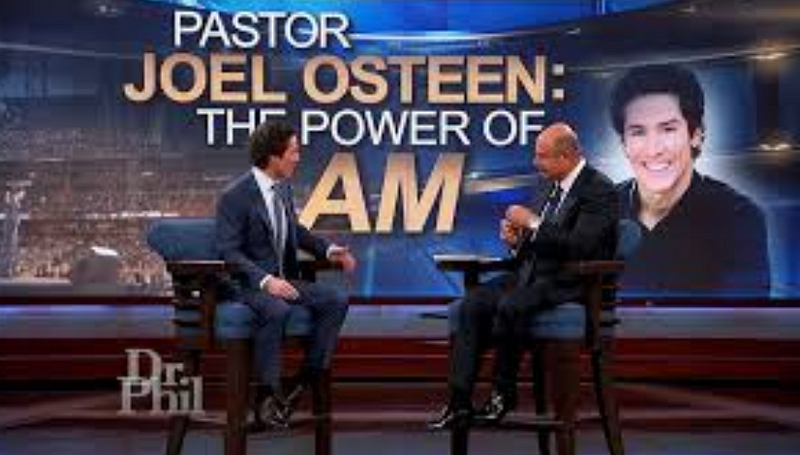
His son, Joel Osteen, was a highly conscientious TV producer for the ministry, after studying Radio and Television Communications at… drum roll… Oral Roberts University. Only Joel didn’t graduate; nor did he go to any form of ministerial training. Why would he? He was all about TV, and televangelism networks like TBTN were booming.
He’d also noted the televangelism scandal problem, and the public’s growing cynicism over preachers emotionally-blackmailing them for cash, which they spent on luxury. The supply lines were drying up from growing cynicism.

Slightly further away in Missouri, a young girl from an appallingly abusive background named Joyce Meyer had had some serious troubleswith criminality, a drunk father feeding her alcohol, and childhood “conversion”:
“As a girl, Meyer recalls, she had a fascination for the spiritual: stories of extrasensory perception, science fiction and horror movies.
She said she was drawn to hypnosis and astrology, “any kind of a carnival.”
“I would go by the fortune teller’s booth or the person who was reading the tarot cards … or I would always want to have somebody look into the crystal ball for me,” she said.
Meyer said she routinely stole “about anything I could get my hands on” as a child, including “stuff I didn’t even need.” Once, she said, she stole a pair of eyeglasses from a friend’s home.
That was until she had a “miraculous” message from God in 1976 at a bowling alley:
“That evening, as she drove home from a beauty shop appointment, God filled her “full of liquid love,” she said. That night, at a local bowling alley, she felt almost drunk with the spirit of God.”
Drunk? Liquid love? In the same article describing how her father plied her with alcohol?
She became a pastor at a charismatic young church and started small radio broadcasts which morphed in a TV ministry. It’s content? Take a guess.
“With words, we can reach into that spiritual realm, and we can begin to pull things out that are God’s will for us, and get them over here into the realm where we can make use of them. Words have power.”
“We are created in His image, and we can also call things that are not as though they are. We can speak positive thoughts about ourselves into the atmosphere and thereby ‘prophesy our future.”
Fast forward to 1997, where the familiar story goes, John Osteen died and his humble, reticent TV assistant son stepped up to be Lakewood’s leader. A “miracle” growth in the church occurred.
Only a small problem: the “bumbling fool” story is rather at odds with what the Houston Chronicle reports on Osteen’s rise — by far the most comprehensive — which paints a picture of an unusually ambitious young man:
He began to craft sermons with the same meticulousness he had shown as a TV producer, retreating on Wednesday and emerging on Saturday with seven single-spaced pages that he had committed to memory. He rehearsed them until the delivery seemed effortless. After Sunday’s service, he edited the recording for broadcast, frame by frame.
“He was extraordinary in the sense that he was all about details,” Cooke said. “And he always had the long view in mind.”
In 2003, Lakewood bought airtime in over 25 channels and started trademarking.
Soon after taking over, Osteen hired Duncan Dodds, an ordained Southern Baptist minister who was also a branding specialist.
Wait. Why does a church need a branding specialist?
Osteen’s takeover of Lakewood reads like the mass-expansion of an American corporation: deliberate, strategic, bold, multi-million-dollar lobbying; but one thing was missing: an actual message. A creed. An ethos. That old-hat fire and brimstone stuff wasn’t going to work. It needed re-branding.
The answer? Wait for it…. Words. Speech. Positive Thinking and Declaration. Creative Visualisation. Changing your beliefs to change reality. Claiming God’s wishes of prosperity, health, wealth, and success for your life. You can cancel out God’s plan your life with negative thoughts and words.
The American Dream with Pentecostal philosophy — and the type of fluff any secular person — like Oprah’s audience — could get into. It was the old Word-Faith ideas for a new audience.
“You’ve got to speak it out. Your words have creative power. One of the primary ways we release our faith is through our words. There is a divine connection between you declaring God’s favor and seeing God’s favor manifested in your life. And some of you are doing your best to please the Lord. You are living a holy consecrated life, but you’re not really experiencing God’s supernatural favor. And it’s simply because you’re not declaring it. You’ve got to give life to your faith by speaking it out.” (Audio clip from Bible Answer-Man Broadcast, April 26, 2004).
It was Copeland’s doctrine, from Hagin: faith is an unseen force released by words through which you can alter materiality reality — and even be healed! It was the “Law of Attraction”, but the Jesus version. Speak words and promises of Faith and Victory over your life.

Osteen managed to reverse the “negative” need for the religious declaration — say, for example, in paganistically exorcising objects “contaminated” with “demonic” influence you might find in your house — into am opposite, “harmless” form of positive magical thinking for the Christian family.
Like most New Thought promoters, Osteen got seriously, seriously rich: a $10.5M house, a $50M fortune, and the largest church in America. All on a $1 salary from Lakewood, as a living example of the so-called “truth” of his teachings — God’s intrinsic “favour”, almost by… magic. There are even blog posts on his own website literally entitled “A Word of Faith”.
And all of it virtually… harmless.
There were a few problems: it was supposed to be a church, he was de facto “put” into position by his mom, and absolutely none of it was even slightly biblical. Other church leaders starting calling him out for heresy. His wife, Victoria, having faced down allegations of assault, has been derided for her staggering ignorance of theology. The Bible doesn’t have the slightest thing to do with “self-help”.
Even Vox, observably one of the worst agitprop sewers of journalism, figured out something was wrong.
As Sorkin writes so insightfully in the West Wing when President Bartlett exclaims to his lawyer, in the midst of an investigation into whether he was dishonest in concealing his MS:
LEO
I mean, in the two and a half hours we’ve been sitting here have you discovered one thing that he’s done wrong?
OLIVER
No.
LEO
So, what’s your problem?
OLIVER
That’s my problem, Leo. Are you out of your mind? He did everything right. He did everything you do if your intent is to perpetrate a fraud.
Osteen, like all the “New Thought” and“Word-Faith” leaders, as well as that long line of Oprah guests with books to sell which came before him, — and even after — made their cash through publishing. The church is merely a peripheral add-on, in the same way Facebook sells data but has a social media site.
No-one who makes Osteen’s kind of money is any kind of fool; he lived through the televangelism scandals and studied Oprah’s formula as he worked in TV. You can almost hear the detail-obsessed man’s careful list: no association with televangelist fund drives, no mention of Word-Faith, $1 salary for transparency, the maximum audience reach.
Joyce Meyer‘s resulting TV and publishing empire, despite an IRS probe and Senate investigation, also did extraordinarily well: a $10M corporate jet, and tens of millions of dollars in property. The circular logic she pioneered which gave Osteen the same helpful out-clause they needed to show their material wealth was proof of the truth of their doctrine?
“There’s no need for us to apologize for being blessed.”
Yes, their persecution for their success managed to become undeniable evidence what they were teaching had so much power. Now that is some next-level spin doctoring.
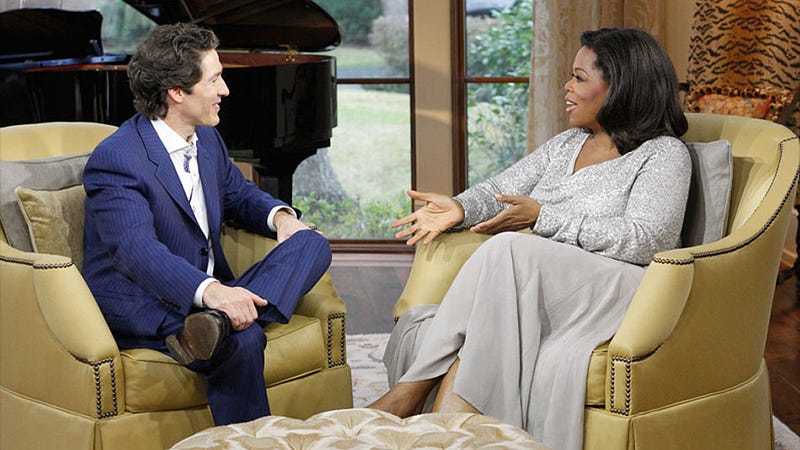
Unsurprisingly, Oprah fell in love with Joyce Meyer, and eventually, Joel Osteen. His sermons Changed Her Life (TM) like all the other teachers and books changed her life. And their audiences, coincidentally, were almost identical. After he went one louder with a book which angered so many people so widely it literally earned a top spot right in the Neopaganism section: “The Power of I AM”, the game was up.
Sadly for Joel, his marketing team didn’t do their research as deeply as they probably should have. The title correctly got grouped in with the others — all of them New Thought, or New Age.
- “The Power of I AM” (David Allan)
- “The Power of I AM and the Law of Attraction” (R. J. Banks)
- “The Power of I Am: Aligning the Chakras of Consciousness” (Geoffrey Jowett)
- “I AM: The Power of the Hero Within You: The Quick Guide to Manifesting Your Dreams” (Dana Dae)
- “The Power of the Eternal Now: Living in the Realm of I Am” ( Jeremy Lopez)
Etc, etc, and more etc, ad nauseam.
American Mysticism, New Thought, and Prosperity Theology were back, and bigger. And this time they weren’t just on dedicated religious TV networks for the fundamentalists; they were for a previously untapped audience of evangelicals. Their expansion into commercial daytime program programming and the market of everyday people meant they were mainstream.
“17 percent of Christians surveyed said they considered themselves part of such a movement, while a full 61 percent believed that God wants people to be prosperous. And 31 percent — a far higher percentage than there are Pentecostals in America — agreed that if you give your money to God, God will bless you with more money. … Of the four biggest megachurches in the country, three — Joel Osteen’s Lakewood in Houston; T.D. Jakes’ Potter’s House in south Dallas; and Creflo Dollar’s World Changers near Atlanta — are Prosperity or Prosperity Lite pulpits.
In 2007, U.S. Senator Charles Grassley, (R-Iowa), a member of the Finance Committee, sent letters to six Word of Faith ministries about complaints he had received regarding nonindependent boards and ministers’ lavish lifestyles. The ministries didn’t include Lakewood Church.
- Benny Hinn Ministries; Grapevine, Texas; Benny Hinn;
- Kenneth Copeland Ministries; Newark, Texas; Kenneth and Gloria Copeland;
- Joyce Meyer Ministries; Fenton, Missouri; Joyce and David Meyer;
- Bishop Eddie Long Ministries; Lithonia, Georgia; Bishop Eddie L. Long;
- Without Walls International Church; Tampa, Florida; Paula and Randy White;
- Creflo Dollar Ministries; College Park, Georgia; Creflo and Taffi Dollar.

Anyone who has lived in Africa or the Caribbean — where Oprah is a folklore Goddess — knows the staggering, devastating impact of Prosperity Gospel fraud. As ThoughtCo notes:
“In Africa, Word of Faith is sweeping the continent. Christianity Today estimates that more than 147 million of Africa’s 890 million people are “renewalists”, Pentecostals or charismatics who believe the health and wealth gospel. Sociologists say the message of money, cars, houses and the good life is almost irresistible to poor and oppressed audiences.”
The Secret: Not So Secret Really
But perhaps the best-known shitshow resurrecting “New Thought” (other than the established “churches”) emerged in 2004, from an Australian woman, Rhonda Byrne, who had just lost her father, and found herself reading Wallace Wattles’ century-old dusty thesis “The Science of Getting Rich” (1910).

The “Science” mention in the title obviously doesn’t refer to, erm, science, and the preface states quite clearly it’s another Methodist rehashing of supposedly “Hindu” ideas (“One is All, and that All is One”, technically Monism, and also coincidentally Bill Hicks’ favourite rant), with lots of magical talk about The Will.
The astute will recognise this terminology again, from Crowley’s mindless nonsense:
“The central philosophy of Thelema is in two phrases from Liber AL: “Do what thou wilt shall be the whole of the Law” and “Love is the law, love under will.”
140 years later: same old, same old. You can affect objective material reality with your mind. Like casting a spell with your thoughts and speech. Like every “secret” knowledge, it’s not speculation — it’s a “technique” or a “technology”.
Just like Franz Mesmer.

Three years later in 2007, after promotion by Oprah, “The Secret” had sold almost 20 million copies. It was followed in 2010 by “The Power”, then in 2012 by “The Magic”. What was this secret? Ask, believe, and receive! The mysterious…. “Law of Attraction” from New Thought.
She also got very rich; and credits the Bible, Norman Vincent Peale, et al.
What may be more pertinent to ask is if she’d read the (rather antisemitic) “The Secret Doctrine” (1888) by theosophist Helena Blavatsky, who ripped that off a sizeable collection of people. The “revelation” claim for the ideas — very similar to Byrne’s (just with one word removed from the title) — are as fanciful as Crowley’s:
“[Blavatsky] claimed to have received her information during trances in which the Masters of Mahatmas of Tibet communicated with her and allowed her to read from the ancient Book of Dzyan. The Book of Dzyan was supposedly composed in Atlantis using the lost language of Senzar.”
Err, what?
Gratitude: The New Harmless Spiritual Superpower
A generation overwhelmed with information has had a hard time with all that thinking. Sometimes they just want peace and quiet. The internet-connected life, from its Hate Machine, to its sewer; to its 24–7 biased media; to its cyberbullying and doxing, right through to its billion-quadrillion startups with their bad ideas, can be exhausting.

You don’t just need Yoga. You need a new type of mind science; to be present in the moment as a mode of being. Whatever that hell any of that means.
Are you grateful? Do you practice stillful mindfulness to enhance the yearnings of your inner soul and bring blessings into your life?
The Washington Post traces this Barbie thinking back to…. guess where.
Most people credit Oprah Winfrey with promulgating the ever-present term “attitude of gratitude” But the slogan and its outlook originated in a 1909 book called “The Ideal Made Real,” by American mystic Christian D. Larson.
“The attitude of gratitude,” wrote the native Iowan, “brings the whole mind into more perfect and more harmonious relations with all the laws and powers of life. The grateful mind gains a firmer hold, so to speak, upon those things in life that can produce increase.” Larson framed the core principle of today’s gratitude movement.
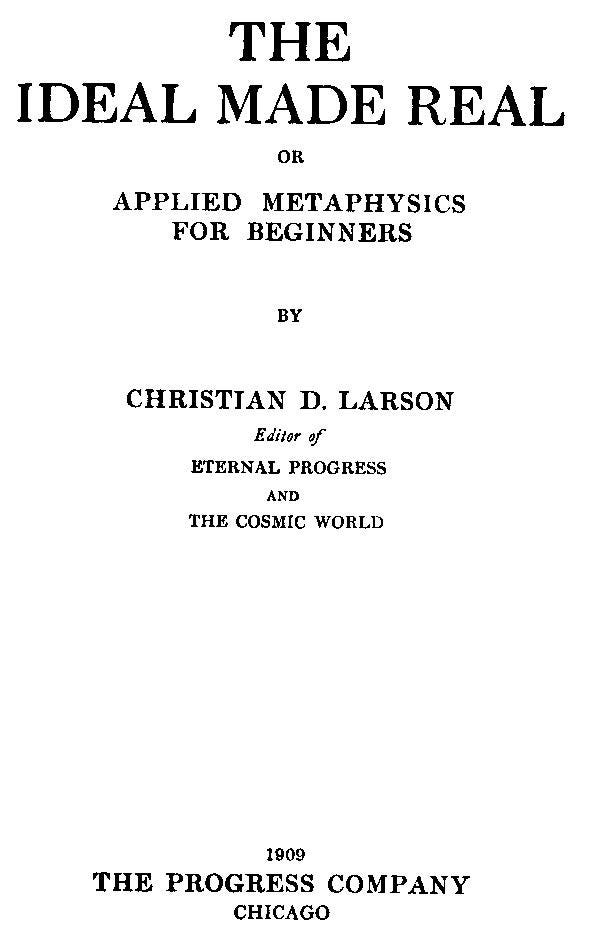
Christian D. Larson was, surprise surprise, a prolific New Thought Alliance member who was rather obsessed with Ernest Holmes, the founder of Religious Science. The content of “The Ideal Made Real or Applied Metaphysics for Beginners” (1909) should be predictably familiar by now: Christian-y, bible-quotey, kinda-mystic nonsense about your thoughts steering the course of material reality, on top of making you feel nice and calm. And magical.
Now, we have the ultra-trendy concept of the “Gratitude Movement” — which really is as stupid as it sounds.

Mindfulness’ core idea — the search for peace through self-examination and awareness — has its roots in… wait for it… Eastern philosophy, specifically the Buddhist Vipassana movement. We’re at it again, back to the 1960s hippies and New Agers: the private commercialisation of old quasi-spiritual nonsense repackaged as“modern” thought. The humanities students of the bearded Counter Culture professors are the psychology writers of today; and their thinking is lazier than ever
Half of the issue is mindfulness is promoted as a “secular” practice to get rid of all those icky religious stigmas, but it’s basic Buddhism:
- The training of Sati (7 factors of enlightenment): “moment to moment awareness of present events”, but also “remembering to be aware of something”.
- Zazen: just sitting, that is, suspending all judgmental thinking and letting words, ideas, images and thoughts pass by without getting involved in them.
Woah. Deep.
More astute readers will recognise echoes of this idea in the West from Transcendentalism, one of the precursors of Western Esotericism:
Transcendentalism has its origins in New England of the early 1800s and the birth of Unitarianism. It was born from a debate between “New Light” theologians, who believed that religion should focus on an emotional experience, and “Old Light” opponents, who valued reason in their religious approach.
The individual most closely associated with the repackaging of Hindu ideas and practices for the West, — including meditation and yoga — was Swami Vivekananda, who, around 1880, was heavily influenced by the syncretism of Unitarianism and Hinduism emerging in India.
Transcendentalism was the precursor of “New Thought”.
The repackaging cycle simply continues.
A Million Recipes for Old Snake Oil

It’s never wise to ascribe intent where there is no concrete evidence of it, or even surmise it from the context. It is almost certainly not the case that the Winfreys, Meyers, and Osteens of the last 50 years actively set out to repackage New Thought into a rebranded, syncretic version of malevolent Christianity in some deliberate conspiracy.
Unlike Byrne, it’s far more likely they literally had no idea what it is, where it came from, nor any idea what they were teaching. It just felt good, and it worked. Moreover, their audiences want to believe in magic and be told what they want to hear.
The result, however, has been bad fruit, because a bad tree bears bad fruit.

The formula for making a gazillion bucks off ancient New Thought booklets seems to go a little something like this:
- Have a pre-conditioned susceptibility for Magical Thinking.
- Desire significance, or have financial difficulties.
- Read an esoteric publication from the late 20th Century, or one which has been re-packaged with a new cover. Believe you can affect your material reality or circumstances through words and thoughts, and get convinced all these books about the same ideas are an ancient secret.
- Re-package the same ideas as a new approach and claim it is mysterious alternative knowledge you are providing a fresh interpretation of.
- Find a platform to sell it to other people who are Magical Thinking types. Preferably a radio or TV personality who others already trust.
- Profit.
- Claim your personal success is not down to you recycling an old trope for cash, but a direct manifestation of you putting the idea into practice.
- Repeat for a few sequels.

The formula for Pentecostal preachers is a little more tricky, as there is that pesky, annoying Jesus person in the way; not to mention the established Church, all those previous cults and scandals; on top of some tough, purist pastors who tend to publicly call heretics out when they mangle scripture to mix it with more esoteric ideas God doesn’t mention:
- A disaffected/insignificant pastor or religious worker without formal religious training or education reports a dramatic “conversion” experience.
- They disconnect themselves from their former, or any, mainstream denomination of the Christian church.
- They adopt a new “approach” and/or integrate a new set of ideas into traditional Christian teaching, which gains them popularity and success. Often it involves tales of extraordinary events and miracles occurring during their ministry, confirming what they already believe or say.
- The approach presses on a Magical Thinking “nerve”, which is often pre-activated or conditioned in an audience, and encourages them they, themselves, can take control of their own material reality for their own prosperity— mostly through speech or thought.
- They reinforce the authority of the message through pre-existing historical material, a newly-founded school/institute, and self-evidence (i.e. their own success).
- Their audience grows at an astonishing rate to an enormous size which is suggested as validation of the ministry itself.
- They “doctrine-ise” the teaching through publishing and amass a large amount of wealth.
- When challenged on the legitimacy of their “approach” or teaching, they claim they are being unfairly chastised because of others’ envy of their success — citing it as evidence of the reality and validity of their teaching.

Everyone is entitled to believe as they wish, — provided it harms no-one else — and that includes thing which are wacky, stupid, irrational, or downright dumb. Paganism, for example, is a broad church which thrives on it.
Obscuring the origin of something— either through omission, ignorance, or deception — is, in effect, an act of laundering it. Integrating something into a system, by subterfuge, with the result of weakening its integrity or contaminating it to mutate its form, is corruption.
The guilty are all around us: the preachers for introducing and teaching it; the church for tolerating it; the congregation for falling for it; but the most reprehensible of all, are those who simply weren’t interested or bothered to wonder if it was true at all.
